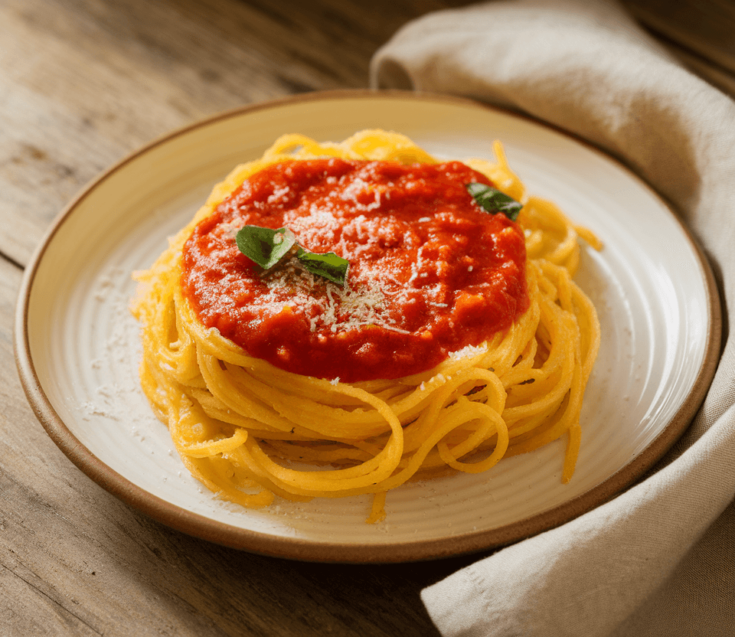Spaghetti Squash Pasta is a delicious and nutritious alternative to traditional pasta, offering a delightful flavor and texture that pairs beautifully with a variety of sauces. This recipe transforms the humble spaghetti squash into a satisfying meal that is low in carbs, gluten-free, and packed with vitamins. With its light, slightly nutty flavor and the ability to absorb sauces wonderfully, spaghetti squash pasta is perfect for those looking to indulge without the guilt.

Why You Will Love This Recipe
You will love this spaghetti squash pasta recipe because it’s not only incredibly flavorful but also easy to make. The squash provides a wonderful base that mimics the texture of traditional pasta while being low in calories and carbs. This dish is adaptable to various diets, including keto, paleo, and vegetarian lifestyles. Plus, it’s a fantastic way to sneak in some veggies without sacrificing taste or satisfaction.
Tips and Tricks
- Roasting is Key: Roasting the spaghetti squash at a high temperature caramelizes the sugars and enhances the flavor. Always cut it vertically for even cooking.
- Use a Fork: After baking, use a fork to gently scrape the insides of the squash to create those spaghetti-like strands.
- Season Generously: Don’t shy away from seasoning your spaghetti squash. A touch of olive oil, salt, and pepper can make a world of difference in flavor.
- Sauce it Up: The squash absorbs sauces well, so feel free to add your favorite marinara, pesto, or even a cream-based sauce for a richer taste.
Common Mistakes to Avoid
- Overcooking the Squash: Keep an eye on your squash while roasting; overcooking can make it mushy. Aim for a tender texture that still holds form.
- Not Scraping Properly: Make sure to scrape with a fork gently after cooking to achieve those perfect strands. Scraping too hard can break it down too much.
- Ignoring the Preheat: Always preheat your oven to ensure even cooking; starting with a cold oven can lead to uneven roasting.
Make Ahead Tips
Preparation can be made easier by roasting the spaghetti squash in advance. Once cooled, store the strands in an airtight container in the fridge for up to five days. You can also prepare your sauce ahead of time, allowing the flavors to meld beautifully. Just reheat everything when you’re ready to serve.
Recipe Variations
- Sauce Variations: Swap out the marinara for a homemade basil pesto or a rich Alfredo for a different flavor profile.
- Add Proteins: Incorporate shredded chicken, turkey meatballs, or sautéed shrimp for a heartier meal.
- Vegan Option: Use a cashew cream sauce or a store-bought vegan sauce to keep it plant-based.

How to Serve
Serve your spaghetti squash pasta in a large bowl or on a plate, twirling the strands for a beautiful presentation. Garnish with freshly grated Parmesan cheese or nutritional yeast for a vegan option, along with a sprinkle of fresh basil or parsley. Pair with a side salad for a refreshing touch.
Pairing Suggestions
For drink pairings, a crisp, chilled white wine such as Sauvignon Blanc complements the dish well. If you prefer cocktails, a light gin and tonic with fresh lime is refreshing. As for desserts, a light sorbet or fruit salad can cleanse the palate beautifully after this veggie-forward meal.
How to Store
Store leftover spaghetti squash pasta in an airtight container in the refrigerator for up to five days. For longer storage, you can freeze the cooked strands in a freezer-safe bag for up to three months. When reheating, add a splash of water to prevent drying out.
Equipment Needed
- A sharp chef’s knife for cutting the squash
- Baking sheet for roasting
- Fork for scraping the squash strands
- Mixing bowl for combining ingredients
If you don’t have a baking sheet, a casserole dish will work just fine!
Dietary Adaptations
To make this dish vegan, simply replace any dairy-based sauces with plant-based alternatives. For a nut-free version, ensure your sauce does not contain nuts and use sunflower seed butter for creaminess if needed. For gluten-free needs, this recipe is naturally gluten-free as spaghetti squash contains no wheat.
Seasonal Adaptations
In the summer, incorporate fresh vegetables like zucchini, bell peppers, or cherry tomatoes to add color and flavor. In the fall, consider adding roasted butternut squash or a sprinkle of pumpkin spice to enhance the seasonal vibes.
Cost Breakdown
The estimated cost for this dish is around $10 for a total of four servings, making it roughly $2.50 per serving. To save money, look for seasonal squash or buy in bulk. You can also make your sauces from scratch to cut down on costs.
Kitchen Hacks
To speed up the cooking process, microwave the spaghetti squash for 5-10 minutes before roasting, which will soften it and make it easier to cut. For easy garlic peeling, crush the cloves with the flat side of a knife, and the skins will slip right off.
Recipe FAQs
- Can I use other types of squash? Yes! Zucchini or butternut squash can be used as alternatives, but the cooking time may vary.
- How do I know when the squash is done? It should be fork-tender and easily scraped into strands.
- Can I make this gluten-free? Absolutely! This recipe is inherently gluten-free as spaghetti squash contains no wheat.
Spaghetti Squash Pasta

Spaghetti Squash Pasta is a delicious and nutritious alternative to traditional pasta, offering a delightful flavor and texture that pairs beautifully with a variety of sauces. This recipe transforms the humble spaghetti squash into a satisfying meal that is low in carbs, gluten-free, and packed with vitamins.
Ingredients
- 1 medium spaghetti squash
- 2 tablespoons olive oil
- Salt and pepper to taste
- 1 cup marinara sauce (or sauce of choice)
- 1/4 cup grated Parmesan cheese (optional)
- Fresh basil for garnish
Instructions
- Preheat your oven to 400°F (200°C).
- Carefully cut the spaghetti squash in half lengthwise and scoop out the seeds.
- Drizzle the insides with olive oil and season with salt and pepper.
- Place the squash cut-side down on a baking sheet and roast for 30-40 minutes until tender.
- Once cooked, remove from the oven and let cool for a few minutes.
- Use a fork to scrape the insides of the squash, creating spaghetti-like strands.
- In a pan, heat your sauce over medium heat until warmed through.
- Toss the spaghetti squash strands with the sauce until thoroughly combined.
- Serve in bowls, topped with grated Parmesan cheese and fresh basil.
Nutrition Information
Yield
4Serving Size
1Amount Per Serving Calories 184Total Fat 10gSaturated Fat 2gTrans Fat 0gUnsaturated Fat 7gCholesterol 7mgSodium 518mgCarbohydrates 21gFiber 5gSugar 9gProtein 4g
Dinnerfocus.com, occasionally offers nutritional information for recipes contained on this site. This information is provided as a courtesy and is an estimate only. This information comes from online calculators. Although allchickenrecipes.com attempts to provide accurate nutritional information, these figures are only estimates.
Final Thoughts
This spaghetti squash pasta recipe is a fantastic way to enjoy a classic meal with a healthy twist. It’s perfect for weeknight dinners or impressing guests with a dish that’s both nourishing and delicious. Enjoy the process and the flavors, and don’t hesitate to make it your own with different sauces and toppings!
